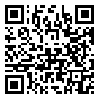BibTeX | RIS | EndNote | Medlars | ProCite | Reference Manager | RefWorks
Send citation to:
URL: http://tumj.tums.ac.ir/article-1-5263-en.html

 1, Shervin Sharifkashani
1, Shervin Sharifkashani 
 , Hashem Sharifian
, Hashem Sharifian 
 , Habib Mazaher
, Habib Mazaher 
 , Peyman Salamati
, Peyman Salamati 
 , Batool Ghorbani yekta
, Batool Ghorbani yekta 

Background: Detection of retained foreign bodies remains a significant problem in the emergency department. Foreign bodies can go undetected causing infectious complications ultrasonography is too inaccessible and expensive. The purpose of this study is comparison of ultrasonography with radiography for the detection of cervical esophageal foreign bodies
Methods: This cross-sectional study evaluated 58 patients referred with suspected upper esophageal foreign body in the Emergency Department, Amir Alam. Patients were evaluated with ultrasonography and x-ray. After surgical exploration, different type of foreign bodies were recorded. The SPSS statistical software was used for analysis. For applicable efficacy outcome measures, a Spearman correlation was used. Differences were significant when P<0.05. All values were expressed as the frequency and present.
Results: Fifty eight patients were studied. 25 patients (43.4%) were male and 31 patients (56.9%) were female, in 28 (48.2%) patients foreign bodies were detected in radiography. 30 patients (51.8%) were not recorded in techniqe. It was found in patients 22 (78.6%) organic body, and six cases (21.4%) non-organic body. radiographic outcomes in patients with foreign bodies were positive in 26 patients (92.9%) and in two patients (7.1%) were negative. Ultrasound results were positive in 27 patients (96.4%) and in one patient (3.6%) were negative. Association of ultrasound and radiography results were significant in patients with foreign body (Spearman correlation=0.896, P=0.001 Kappa=0.890).
Conclusion: These reports suggest that result of ultrasound with radiography for the detection foreign bodies in cervical esophagus have good agreement. The use of ultrasonography in the emergency department to detect and eventually remove foreign bodies by emergency physicians is an important issue because there is not always an ultrasound technologist or radiologist available.
| Rights and permissions | |
 |
This work is licensed under a Creative Commons Attribution-NonCommercial 4.0 International License. |



